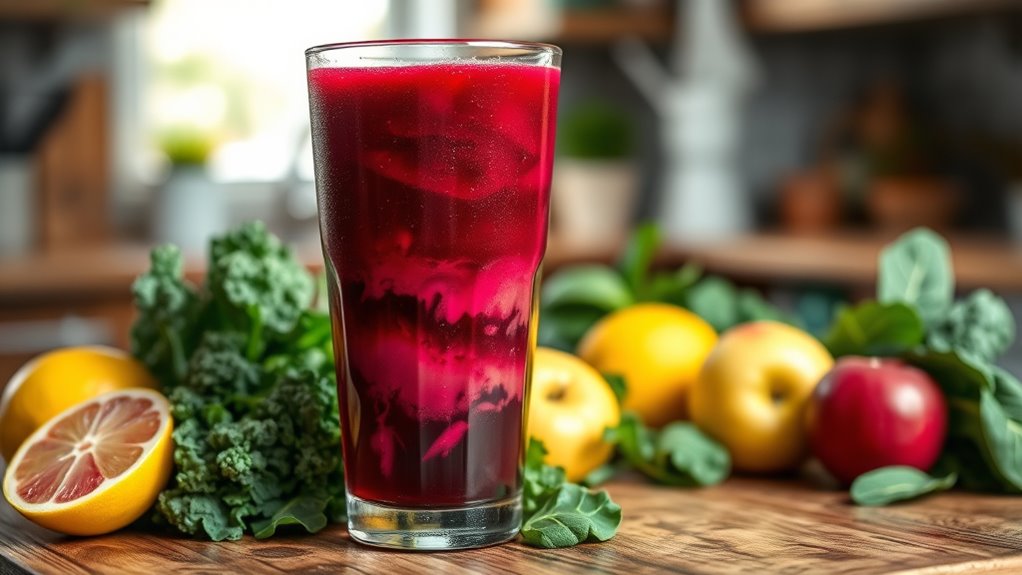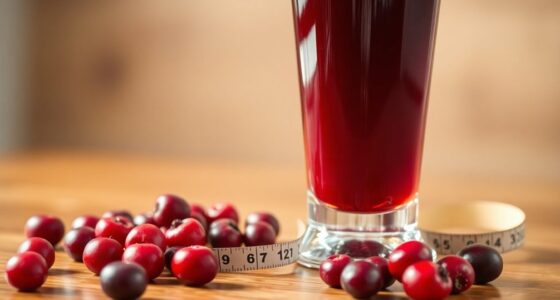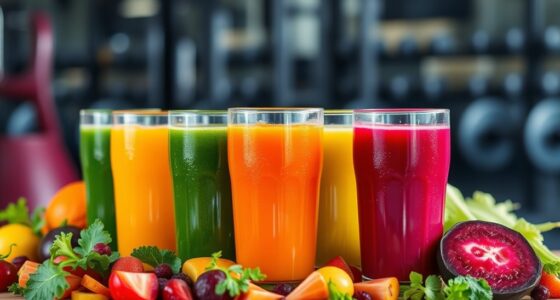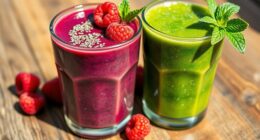Juicing can be a beneficial strategy for managing blood sugar, especially when you focus on low-carb fruits and non-starchy veggies like leafy greens and cucumbers. Choose fresh, nutrient-dense ingredients to help stabilize blood sugar and consider portion control to avoid sugar spikes. Pairing your juice with fiber and protein can enhance its benefits too. If you want to discover even more effective juicing tips for blood sugar control, there’s plenty more to explore!
Key Takeaways
- Juicing can rapidly increase blood sugar levels due to the removal of fiber, so portion control is essential.
- Choose low-carb fruits and non-starchy vegetables to create diabetes-friendly juices that minimize sugar spikes.
- Pair juices with protein and fiber-rich foods to stabilize blood sugar levels after consumption.
- Monitor blood sugar responses closely after juicing and adjust recipes based on personal reactions for better control.
- Consult healthcare providers or dietitians for personalized juicing strategies to effectively manage blood sugar levels.
Understanding the Impact of Juicing on Blood Sugar Levels
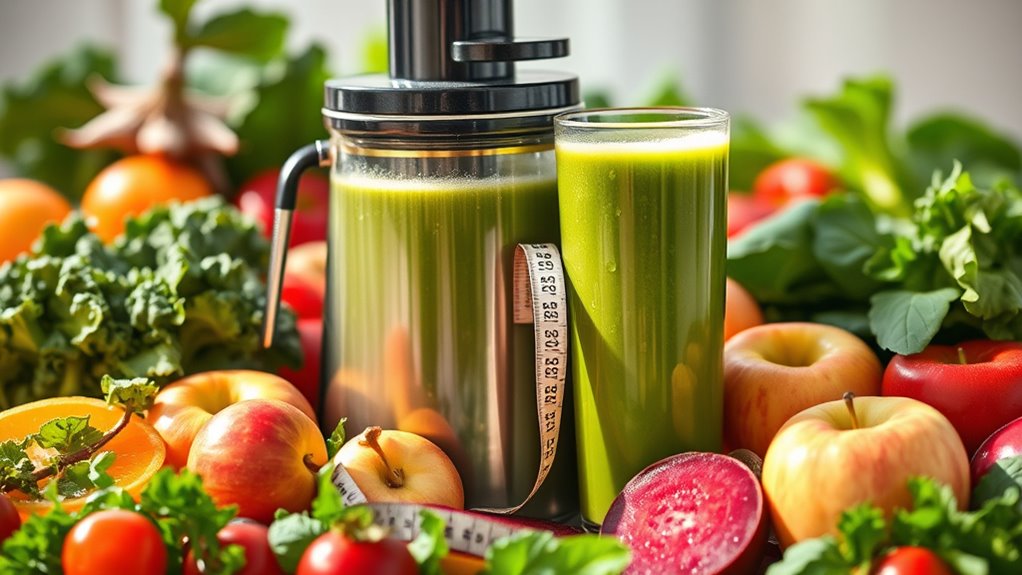
While juicing can offer a quick way to consume nutrients, it can also considerably impact your blood sugar levels.
When you juice, you’re removing most of the fiber from fruits and vegetables, which leads to rapid sugar absorption. Even 100% fruit juice can spike blood glucose levels due to its concentrated sugar content, making caution essential for anyone with diabetes.
To help mitigate these spikes, pair your juice with protein and fiber-rich foods. You might also want to choose lower-carb fruits and vegetables for juicing to minimize blood sugar response while still getting essential nutrients. Additionally, incorporating detoxifying juices into your routine may support overall health and help stabilize blood sugar levels.
Pairing your juice with protein and fiber-rich foods can help minimize blood sugar spikes.
Finally, keep portion control in mind; limiting your juice intake to 4 to 8 ounces daily can better manage your blood sugar levels.
Choosing the Right Ingredients for Diabetes-Friendly Juices

When you’re crafting juices for better blood sugar control, choosing the right ingredients is key.
Focus on low-carb fruits like berries and green apples, and don’t forget the benefits of non-starchy vegetables like cucumbers and spinach. Additionally, incorporating juices like tomato juice can provide essential nutrients while keeping sugar levels low.
These choices can help you create delicious, diabetes-friendly juices that keep your blood sugar levels stable.
Low-Carb Fruit Options
Choosing the right ingredients for diabetes-friendly juices is essential, especially if you want to keep your blood sugar levels stable.
Opt for low-carb fruits that support your diabetes management while enhancing taste. Here are some excellent options for your juice cleanses:
- Berries: Strawberries, blueberries, and raspberries are low in sugar and high in antioxidants.
- Avocado: High in healthy fats and low in carbs, perfect for smoothies.
- Lemons and Limes: Add a zesty flavor without spiking blood glucose levels.
- Cucumber: A hydrating, low-carb option that refreshes your juices.
- Green Apples: They provide a balanced sweetness with lower sugar content.
Incorporating these fruits can help you enjoy delicious juices while maintaining your health! Additionally, staying hydrated is crucial for overall health, as hydration support plays a significant role in managing blood sugar levels.
Vegetable Juice Benefits
Vegetable juices offer a powerhouse of benefits for managing blood sugar levels, especially when crafted from non-starchy vegetables like spinach, cucumber, and celery. These options are low in carbohydrates, helping minimize blood sugar spikes.
Incorporating leafy greens, beets, and carrots adds essential vitamins, minerals, and antioxidants that support overall health without greatly impacting your blood sugar. Plus, these vegetable juices often retain beneficial phytochemicals that can improve insulin sensitivity and enhance metabolic health.
To further stabilize your blood sugar, consider pairing your juices with healthy fats or protein, like nuts or avocado. Choosing organic vegetables can also help reduce your exposure to pesticides, promoting better health outcomes as you manage diabetes. Additionally, incorporating aloe vera juice may provide extra support for digestion and gut health, which is beneficial for blood sugar management.
The Importance of Portion Control in Juicing
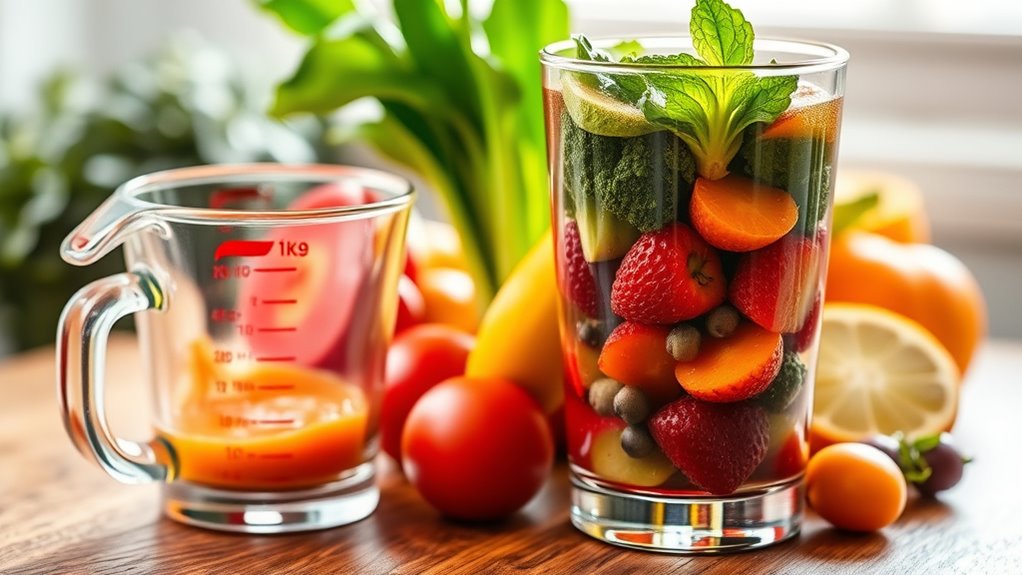
Portion control plays an essential role in juicing, especially for those managing blood sugar levels.
Even small servings can contain concentrated sugars that quickly elevate your blood sugar. To effectively manage your intake, consider these tips:
- Limit juice to 4 to 8 ounces daily.
- Be aware that one serving of juice often requires multiple servings of fruit.
- Monitor portion sizes in relation to your overall meal carbohydrates.
- Pair juice with protein or fiber-rich foods to stabilize blood sugar.
- Track how different juices affect your blood sugar levels.
Incorporating fresh herbs like mint or basil can enhance flavor while providing additional health benefits.
Pairing Juices With Fiber and Protein for Balanced Nutrition

Pairing your juices with fiber and protein can greatly enhance nutrient absorption and help stabilize your blood sugar levels.
When you add whole fruits, vegetables, or protein sources like nuts and yogurt, you’re creating a balanced meal.
This approach not only keeps you full but also prevents those rapid spikes in blood glucose that can come from drinking juice alone. Additionally, incorporating nutrient-rich ingredients can provide essential vitamins that support overall wellness.
Enhancing Nutrient Absorption
When you combine your juices with fiber and protein, you not only enhance nutrient absorption but also support better blood sugar control. This synergy slows sugar absorption, preventing spikes and crashes.
Here are some effective pairings:
- Fruits: Add berries or apples for fiber.
- Vegetables: Include spinach or cucumbers to lower glycemic impact.
- Nuts: Toss in almonds or walnuts for protein.
- Dairy: Mix in yogurt for healthy fats and satiety.
- Healthy fats: Pair with avocados or boiled eggs for balanced nutrition. Additionally, incorporating chia seeds into your juices can further aid in stabilizing blood sugar levels.
Stabilizing Blood Sugar Levels
Combining your juices with fiber and protein not only enhances nutrient absorption but also plays a key role in stabilizing blood sugar levels.
When you pair your juices with sources like nuts or Greek yogurt, you slow down sugar absorption, which helps maintain stable blood sugar levels. Consuming juice alongside high-fiber foods can prevent those rapid spikes often linked to juicing, promoting better glycemic control.
You can also boost fiber intake by adding ingredients like chia seeds or oats to your smoothies. Don’t forget healthy fats like avocado, which can further slow gastric emptying.
Monitoring portion sizes and ensuring your juices are part of a balanced diet will support effective blood sugar management, especially for those with diabetes.
Potential Health Benefits of Juicing for Diabetics
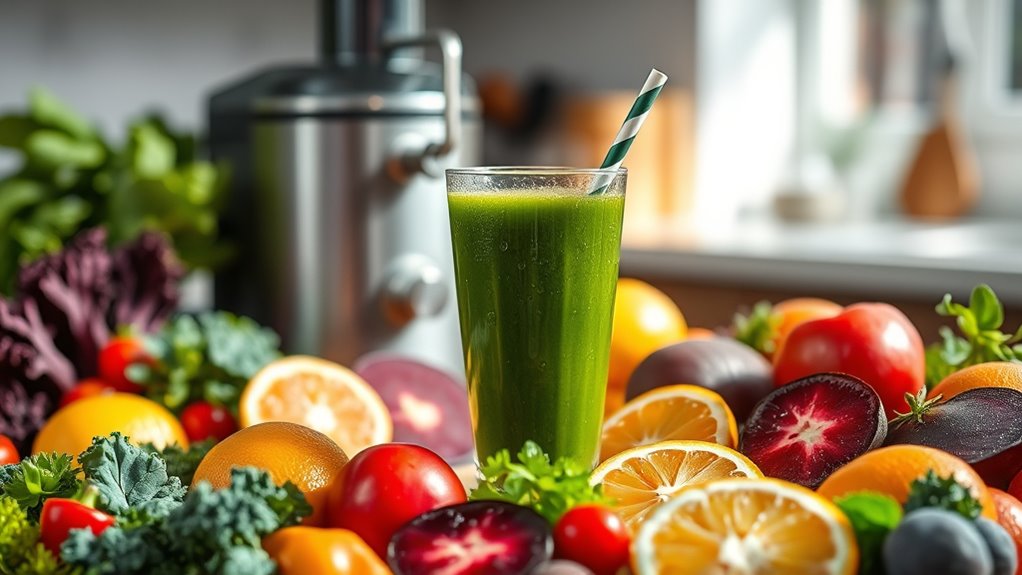
Juicing can offer several health benefits for diabetics, especially when you choose low-carb vegetables and nutrient-rich fruits. Incorporating juices into your diet can help manage type 2 diabetes effectively.
Juicing with low-carb vegetables and nutrient-rich fruits can effectively support diabetes management.
Here are some key benefits:
- Provides concentrated vitamins and minerals.
- Reduces inflammation, supporting overall health.
- Regulates blood sugar levels with low-carb vegetable juices.
- Improves insulin sensitivity with citrus-based juices.
- Positively influences gut bacteria for better metabolic health.
When you enjoy juices in moderation, paired with fiber and protein, you can enhance your nutrient intake.
This can lead to improved blood sugar management, making juicing a valuable addition to your routine. Embrace these health benefits and take control of your diabetes journey!
Practical Strategies for Safe Juicing
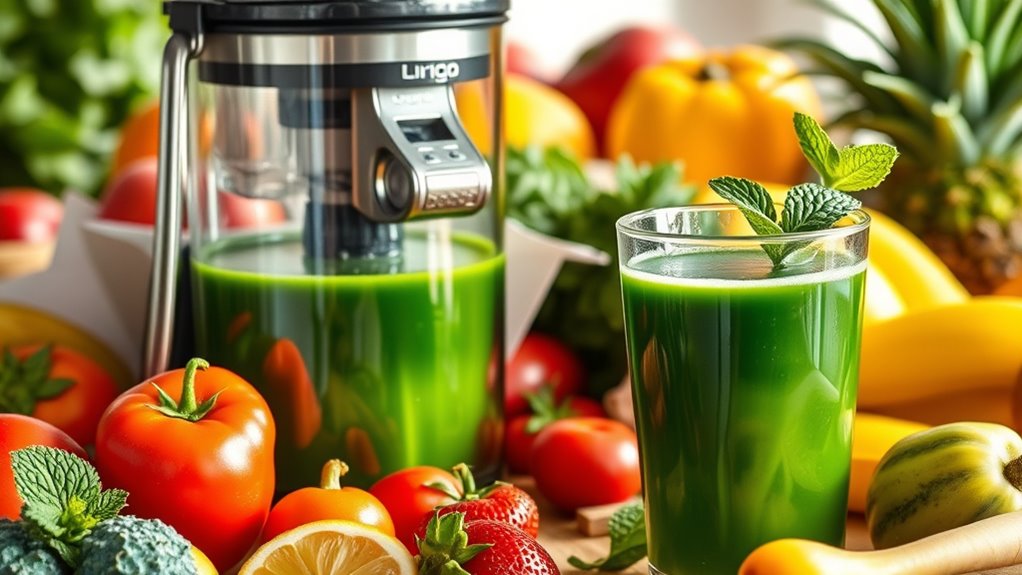
While incorporating juicing into your diet can be beneficial, it’s essential to approach it with caution, especially if you’re managing diabetes.
Start by using a juicing machine to prepare lower-carb fruits and vegetables like cucumbers and leafy greens. This helps minimize blood sugar spikes. Pair your juices with protein-rich or high-fiber foods, such as nuts or a boiled egg, to stabilize blood sugar levels.
Limit your juice portions to 4 to 8 ounces daily and monitor your blood sugar responses closely after drinking. Always choose homemade or 100% juices without added sugars, as store-bought options can contain hidden sugars. Additionally, ensure your juices are high in antioxidants, as they can aid in metabolism and fat burning.
Finally, consult with a healthcare provider to verify your juicing plan aligns with your individual blood sugar management strategy.
Expert Tips and Recommendations for Juicing With Diabetes
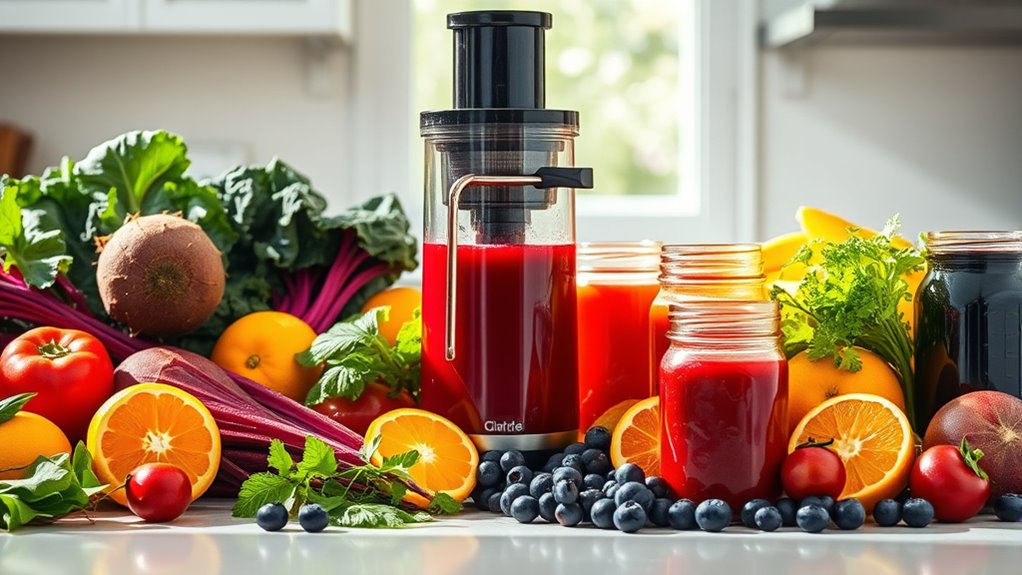
Managing blood sugar levels while enjoying the benefits of juicing can be tricky, but with the right approach, it’s definitely achievable. Here are some expert tips to guide you:
- Choose lower-carb fruits and non-starchy vegetables like cucumbers, spinach, and lemons.
- Pair your juice with high-fiber and high-protein foods, such as nuts or yogurt, to slow glucose absorption.
- Limit your juice intake to 4 to 8 ounces daily for better blood sugar management.
- Monitor how your body reacts to different juices, as responses can vary greatly.
- Consult with a healthcare provider or dietitian before adding juicing to your diabetes management plan.
Frequently Asked Questions
Does Juicing Help With Blood Sugar?
Juicing can help with blood sugar, but it’s important to choose wisely.
When you opt for lower-carb fruits and non-starchy vegetables, you can minimize blood sugar spikes. Pairing your juice with protein and fiber-rich foods will lead to a more gradual increase in glucose levels.
Remember to watch your portion sizes, as even healthy juices can impact your blood sugar.
What Is the One Fruit That Lowers Blood Sugar?
Have you ever wondered which fruit can help lower blood sugar? Blueberries are a top choice! Packed with antioxidants, they enhance insulin sensitivity and are low in calories and glycemic index.
Regularly eating blueberries can improve your glycemic control, reducing the risk of type 2 diabetes. Just one cup, fresh or frozen, can fit easily into your meals or snacks, making them a delicious way to support your blood sugar management.
Which Is the Best Juice to Control Diabetes?
When it comes to controlling diabetes, juices made from low-carb vegetables like cucumber and spinach are your best bet. They help minimize blood sugar spikes.
You might also consider mixing in fruits with lower glycemic indexes, such as green apples and berries, for a touch of sweetness.
Just remember, portion control is key. Keeping your juice intake to 4 to 8 ounces daily can really help manage those blood sugar levels effectively.
What Is the Drink That Significantly Lowers Blood Sugar?
You might be surprised to find that a simple drink can greatly lower your blood sugar. Many people swear by cucumber juice for hydration and its low glycemic index benefits.
You could also try bitter melon juice, known for its potential to improve insulin sensitivity. Adding a splash of lemon or grapefruit juice may enhance the effect too, thanks to their vitamin C and flavonoids.
Don’t forget about apple cider vinegar mixed with water before meals!
Conclusion
Incorporating juicing into your routine can be a game-changer for blood sugar control. For example, imagine Sarah, a busy professional with diabetes. By blending leafy greens, cucumbers, and a small apple, she creates a revitalizing juice that keeps her blood sugar steady and energy high throughout the day. Remember, it’s all about choosing the right ingredients and pairing your juices with fiber and protein. With mindful juicing, you can take charge of your health and enjoy delicious flavors along the way!
Cindy thoroughly researches juicing trends, techniques, and recipes to provide readers with practical advice and inspiration. Her writing style is accessible, engaging, and designed to make complex concepts easy to understand. Cindy’s dedication to promoting the advantages of juicing shines through her work, empowering readers to make positive changes in their lives through the simple act of juicing.

